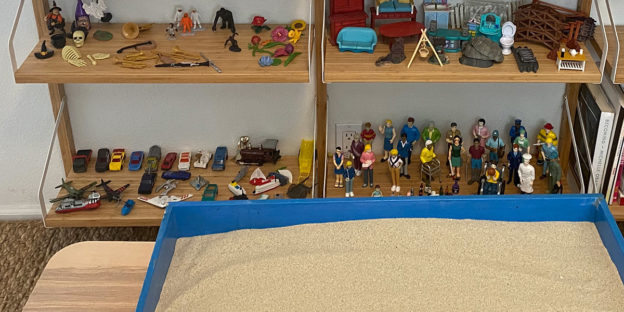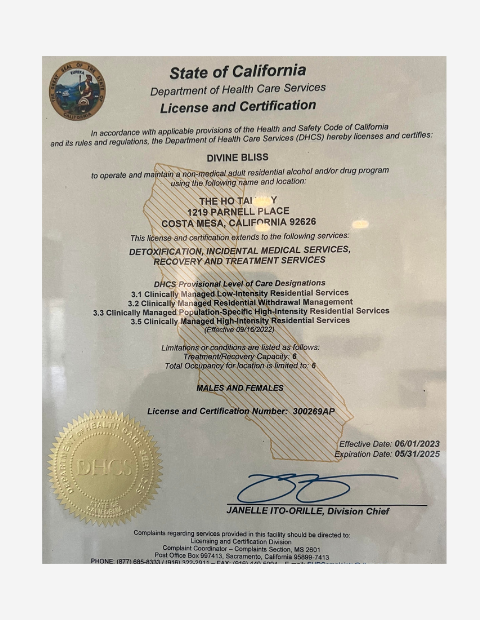“Often the hands know how to solve a riddle with which the intellect has wrestled in vain”
– Carl Jung
In early recovery, it might seem as if you’re thinking is foggy and unclear. You might have difficulty finding the right words or describing your feelings. The Ho Tai Way uses a variety of interventions, including sandplay therapy.
What is Sandplay Therapy?
Sandplay might seem elementary and trivial initially; it is not. Sandplay therapy is an experiential and often nonverbal form of treatment that uses a box or tray filled with sand, miniatures, and sometimes water (Boik & Goodwin, 2000). The miniatures act as the words using symbolism to create scenes in the sand that reflect a person’s inner thoughts, feelings, and concerns. The sandbox acts as a container to hold the thoughts, feelings, and experiences that might be overwhelming were they not contained. Sandplay uses a specific method of therapy using sandtrays.
A tray filled about halfway with sand, along with a variety of miniature figures are chosen to represent a wide array of life in both reality and fantasy. The figures vary by therapist and usually will include people (mythological, different ages and ethnicities), animals (domestic, fantasy, sea, prehistoric), structures (bridges, fences, gates), buildings (schools, churches, homes, castles), elements of nature (stones, gems, seashells, twigs), fauna (bushes, trees, flowers), fantasy (magical, fairy tales, wizards, witches), spiritual-mystical (Western and other religions, crystal balls) (Homeyer & Sweeney, 2011; Garza-Chaves, Timm, & Oeffinger, 2018).
Jungian Sandplay Therapy
Although there are many psychological theories applied to work with sand and miniatures, sandplay therapy is reserved for Jungian psychology. Carl Jung believed that the human mind, soul, or spirit had the capacity for self-healing, finding a voice through symbolism (Gogarty, 2016). Symbolism taps into the unconscious to help find meaning, balance, and healing (Gogarty, 2016). The miniatures represent the unconscious processes that may not be readily available to the conscious mind.
Myth
In a world that might seem hopeless or impossible, we seek out hope and possibility, often through myth (Garza-Chaves et al., 2018). Myth or fantasy helps us make sense of the world. Joseph Campbell, a literary professor who theorized the hero’s journey in storytelling, believed that the hero was self, and the journey represented life (Garza-Chaves et al., 2018). Myths are the language of the unconscious, whereas fairy tales provide a deeper understanding of self that is explored through the creation of the sandtray. The miniatures give the language with which to construct the story of the unconscious.

Example of Sandplay
The picture depicts a completed, portable sandtray. In the picture above, we will focus on the 4-headed, purple dragon, and Ariel. When the dragon was selected, the conscious mind attributed anger to the figure. However, the unconscious mind revealed that the dragon served as the many responsibilities that seem overwhelming. Much like myth and fairy tale, Ariel represented self and the desire to be carefree both consciously and unconsciously.
Who will benefit from sandplay therapy?
Many will benefit from sandplay therapy, especially those who might have difficulty communicating emotions. Clients of substance abuse have used drugs and alcohol to mask “negative” emotions. The problem is that drugs and alcohol mask all feelings. We do not get to pick and choose which feelings we suppress. Early recovery might mean that you struggle to identify your feelings. Tuning into your body might provide clues that you are struggling to communicate. For example, you might feel a lump in your throat, tight shoulders, or clenched jaw. Your body is telling you that something is amiss. Clients who have experienced trauma also benefit from sandplay therapy.
Trauma
The word trauma conjures images of natural disasters, tragedies, or crime victims, to name a few. In the psychological sense, trauma is any event that exceeds a person’s coping ability. A simple car accident might be traumatic for some. In other words, it does not need to be a dramatic event to be considered distressing. Bowen, De Boer, and Bergman (2017) suggested that 55% of persons seeking substance abuse treatment meet the criteria for posttraumatic stress disorder. It is believed that drugs and alcohol were used as a coping skill to mask the feelings of traumatic events (Rosenberg, 2011).
Trauma and the brain
Speechless terror is a result of psychic injury where clients have difficulty putting into words what they are feeling, leaving them with intense feelings and an inability to articulate (Homeyer & Sweeney, 2011). The “fight or flight” area of the brain (amygdala) guides emotion, memory, and behavior (Homeyer & Sweeney, 2011). It is the part that controls biological drives. Broca’s area of the brain is related to language (Homeyer & Sweeney, 2011). When the fight or flight area is activated, the Broca’s area is deactivated, making it difficult to verbalize feelings and experience. The two parts of the brain compete against one another. Sandplay therapy works with the amygdala to allow the unconscious process to flow. The miniatures are the unspoken words that need a voice.
Benefits of sandplay therapy for traumatized clients
- Symbolization – Using a miniature to represent the source of trauma is safer. For instance, a predatory animal can represent an abuser (Homeyer & Sweeney, 2011).
- As if qualities – Clients use the miniatures to manage what was once unmanageable (Homeyer & Sweeney, 2011).
- Projection – Placing intense emotions onto a figure in the sand is safer than verbalizing them (Homeyer & Sweeney, 2011).
- Displacement – Clients can place the negative feelings on the miniatures more safely and comfortably than directly expressing them (Homeyer & Sweeney, 2011).
If you are interested in learning more about how sandplay therapy can help you on your journey of healing, contact our admission team today at (714) 581-3974. The Ho Tai Way is an exclusive women’s only rehabilitation center in Costa Mesa, California, designed with your needs in mind. If you are a current client reading this blog, we understand that you need a place where they can feel safe, vulnerable, and supported. Ask your therapist about sandplay therapy so that you can heal the wounds of your past.
References
- Boik, B. L., & Goodwin, E. A. (2000). Sandplay therapy: A step-by-step manual for psychotherapists of diverse orientations. W. W. Norton & Company.
- Bowen, S., De Boer, D., & Bergman, A. L. (2017). The role of mindfulness as approach-based coping in the PTSD-substance abuse cycle. Addictive Behaviors, 64, 212-216. https://doi.org/10.1016/j.addbeh.2016.08.043
- Garza-Chaves, Y., Timm, N., & Oeffinger, J. (2018). Sandtray, superheroes, and the healing journey. Journal of Counselor Practice, 9(1), 24-38. DOI: 10.22229/tka192034
- Gogarty, H. (2016, March 1). Jungian Sandplay – What is it? Jungian Sandplay. https://www.jungiansandplay.ie/jungian-sandplay-what-is-it/
- Homeyer, L. E., & Sweeney, D. S. (2011). Sandtray therapy: A practical manual (2nd ed.). Routledge.
- Rosenberg, L. (2011). Addressing trauma in mental health and substance abuse. Journal of Behavioral Health Services & Research, 38(4), 428-431.









